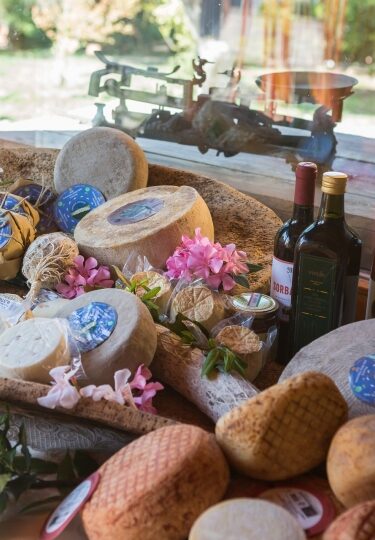While Italian cuisine needs little introduction, regional Tuscan food is a different kettle of anchovies.
What appears on plates in Tuscany owes a large debt to what in Italy is called cucina povera. This ‘cuisine of the poor’ is a philosophy of low waste, humble ingredient cooking born out of the region’s hard history. Due to the tremendous amount of pulses in their diet, Tuscans have earned the monicker mangiafagioli—bean eaters—from their fellow Italians.
Tuscan cuisine, however, is not one-dimensional. This is also the terrain of the prized Chianina breed of cow as well as the terroir of exquisite Brunello di Montalcino wine.
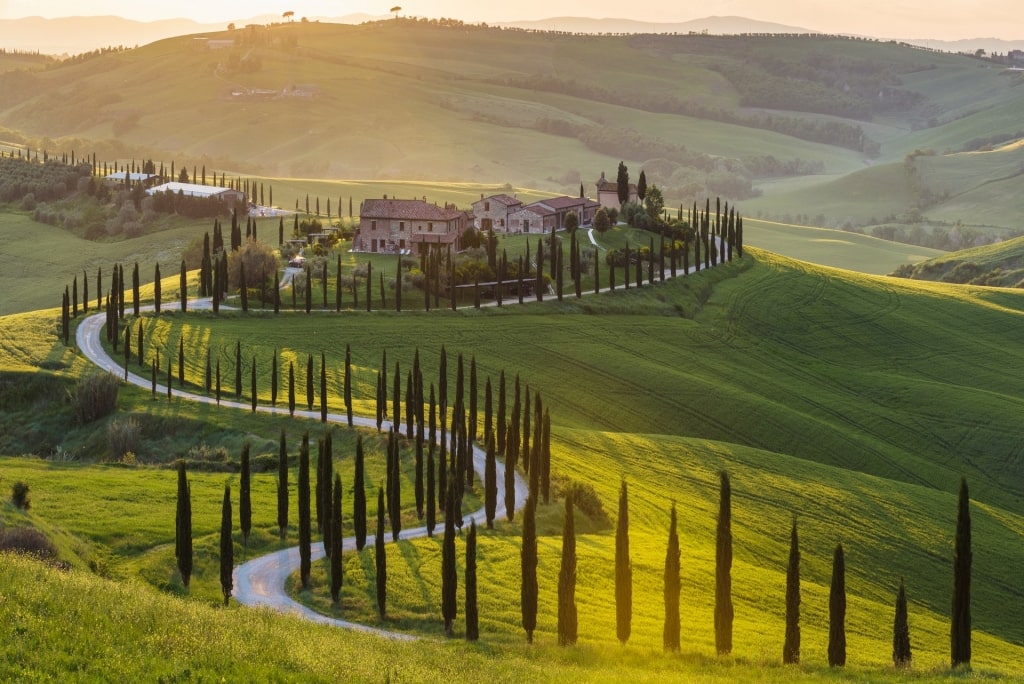
Tuscany, Italy
Tuscany’s geographical location in the Italian boot hints at what you’ll find on the plate. To the north of central Lazio province, Tuscany’s cuisine is influenced by the butter-based heartiness of the colder north, while more Mediterranean flavors sweep up from the south. Its long sea border to the west bears an influx of fresh fish to its tables, while the country’s mountainous Apennine spine forms its eastern limit.
Between are landscapes that, for many, define Italy’s sobriquet as the ‘bel paese’. If you could taste those rolling hills and sun-blushed vineyards, you’d find flavors of sweet chestnut, creamy cannellini beans, and sharp pecorino cheese. While visiting, you’ll encounter some familiar dishes, such as the epic Florentine steak, and many more insular, cultish bites like panino lampredotto.
Here’s a list of incredible dishes to try when visiting Tuscany.
Bistecca alla Fiorentina
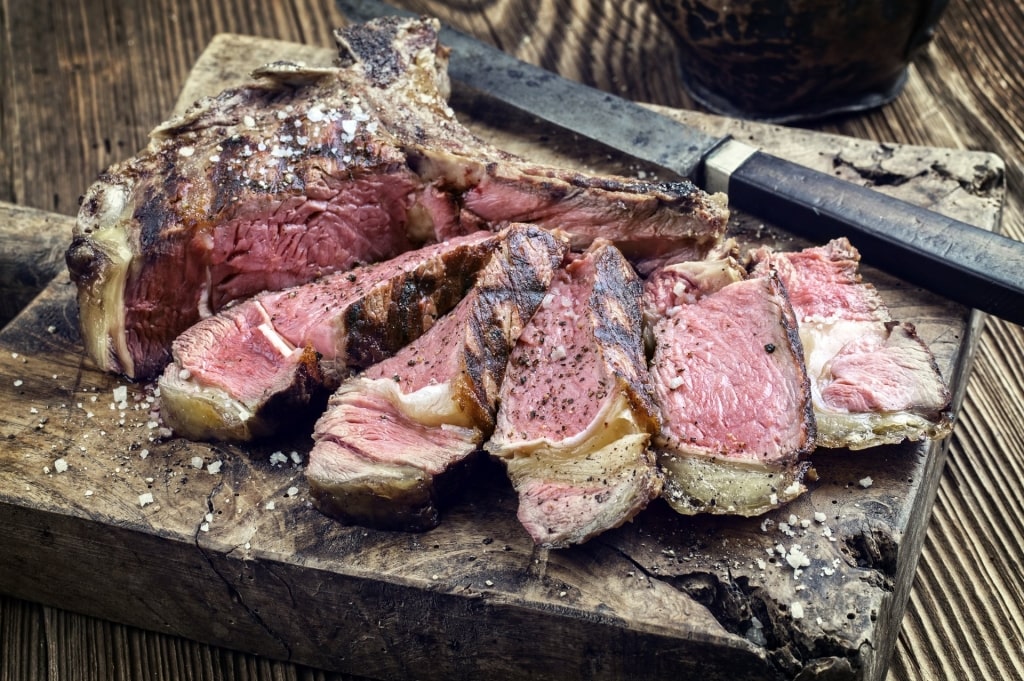
Bistecca alla Fiorentina
The bistecca alla fiorentina, or Florentine steak, is a meat lover’s dream. Essentially a T-bone steak cooked over a wood-fired grill, this is a popular Italian dish that’s intended to be shared. More than just another steak, the bistecca alla fiorentina is an appreciation of one of the world’s most remarkable cattle breeds, the Chianina.
The Chianina’s handsome bone-white flanks have been a familiar sight in the Valdichiana region of Tuscany for over two millennia. The Etruscans sacrificed them to their gods while their heirs, the Romans, worked them in the fields. The tallest and heaviest of all the world’s cattle breeds, the Chianina has more lately been bred for its meat—the most prized in Italy.
Usually served with a side of cannellini beans dressed with olive oil and sage, the steak is simply seasoned with salt and pepper and typically served rare. A knob of herb butter or a lemon wedge (seen as sacrilege by some Tuscan food traditionalists) may come as an accompaniment.
Crostini Toscani
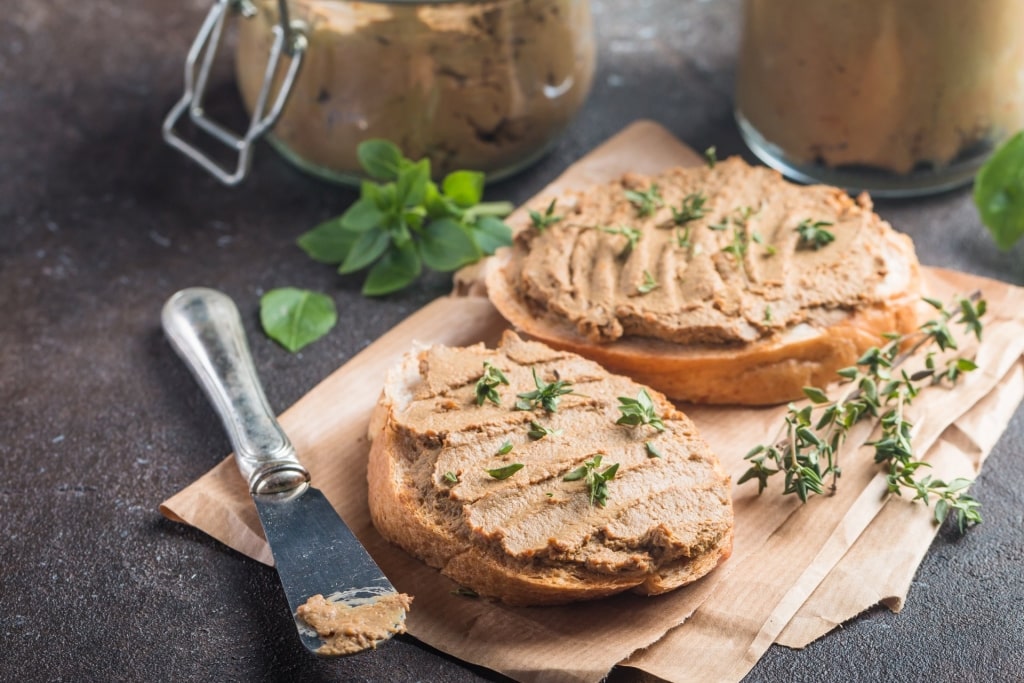
Crostini Toscani
In Tuscany, crostini toscani are the traditional antipasto of a celebratory feast. However, while respect for tradition remains strong in Italy, these deeply savory mouthfuls of chicken liver pâte spread over toasted bread slices have become more common outside of celebrations—they’re too delicious to eat only a few times a year. The pâte’s rich depth comes courtesy of the onion, sage, white wine, capers, butter, and anchovies that the chicken livers are cooked with.
This must-have mouthful of Tuscan cuisine also has a weighty role in culinary history. When Catherine de Medici left Florence to become the Queen of France in the 16th century, her imported Florentine chefs introduced the French to these delicious morsels. This revelation, according to some sources, apparently became the inspiration for foie gras.
Pappa al Pomodoro
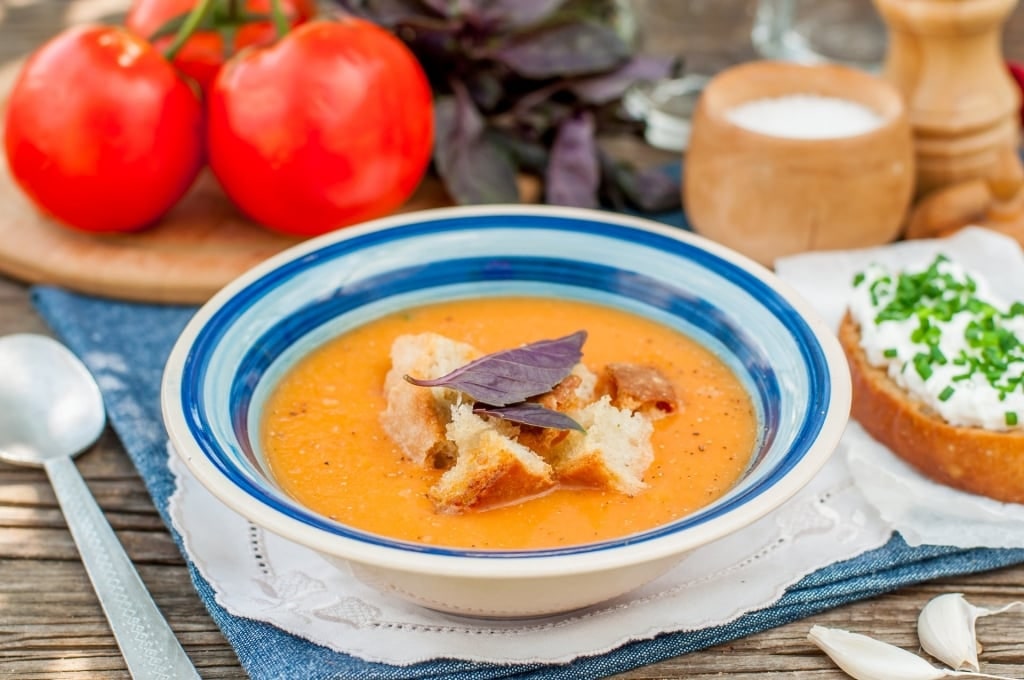
Pappa al Pomodoro
The Tuscans are famous for their large shield-shaped loaves of salt-free bread, known as pane sciocco or ‘stupid bread’. Eaten this way for nearly a millennium, the locals have adapted to the short shelf life of this creamy loaf by incorporating its stale leftovers into their cooking. Perhaps the most famous example of this is pappa al pomodoro.
An emblematic dish of cucina povera, pappa al pomodoro translates as ‘mush with tomatoes’. The stale pieces of pane sciocco supply the mush to a soup of ripe tomatoes cooked in hearty stock alongside a medley of quintessentially Italian flavors: olive oil, garlic, onion, and fragrant basil. The boiled down result is a popular rich red soup, lumpy with saturated bread crumbs, that has a warming depth of flavor.
Ribollita
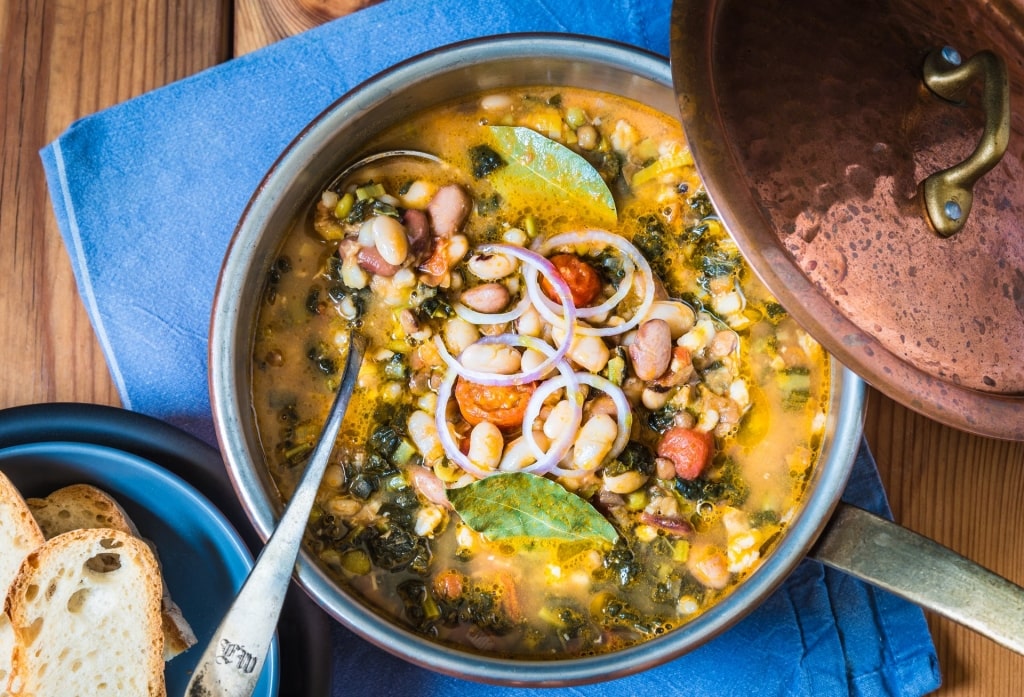
Ribollita
Ribollita is a former staple of impoverished Tuscans that has since become a menu mainstay of regional trattorias. This cucina povera classic is a filling, nutritious vegetable stew intended to fuel a hard day’s farm work.
Ribollita translates as ‘reboiled’—another example of the music in the Italian language for even the most mundane of words. Its origins may reach into the pre-Renaissance era, when servants, clearing away the remnants of their lords’ banquets, reheated the leftovers for their own dinners. Alternatively, the name may have come from peasants making ribollita out of yesterday’s minestrone soup.
A reboiling certainly takes place during the stew’s creation. After it’s been cooked, it’s left to sit overnight before being reheated the next day to serve. Those lucky enough to be sitting around the table will enjoy a thick, bready stew of creamy cannellini beans, earthy cavolo nero kale, and, ideally, a glass of Chianti Classico to wash it down with.
Lampredotto
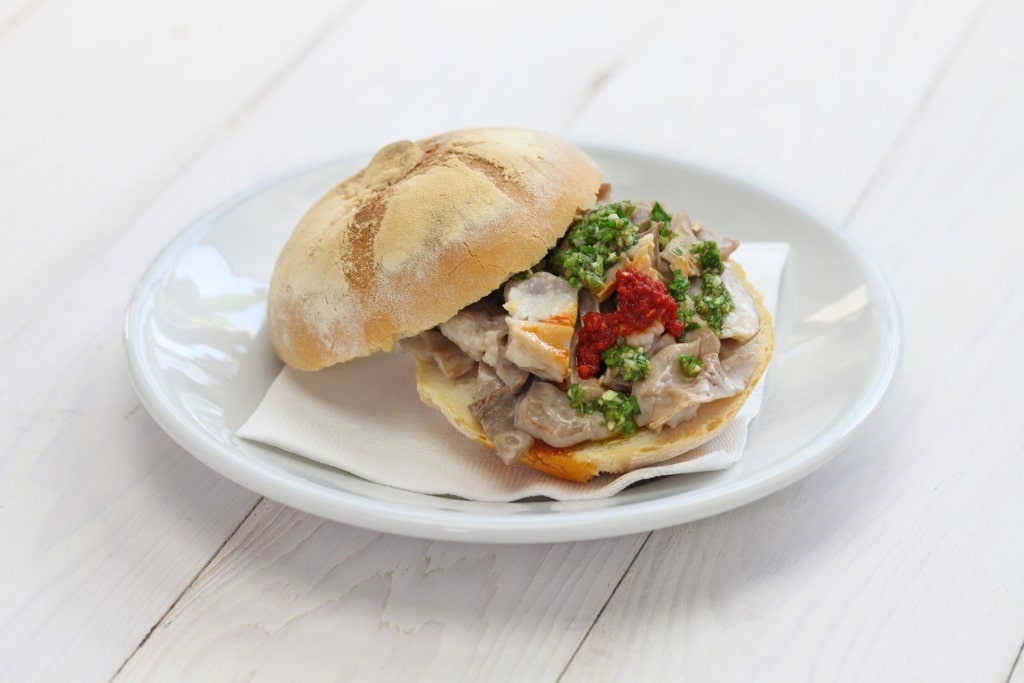
Lampredotto
After wandering the medieval streets that Florence is known for, it’s a rite of passage to get in line at a trippai street stall and try a panino con lampredotto.
The beloved stewed offal sandwich of the Florentines offers a mouthful of deliciousness served with a side of history. In 13th-century Florence, the working classes, excluded from the banquets of their betters, contrived a delicacy from whatever meat remained available to them. The chosen cut was the abomasum—the fourth stomach of the cow—stewed and seasoned with black pepper before being served in a bread roll with salsa verde.
This became the fuel that built Florence. Today, the love of a hot panino con lampredotto crosses all social and economic demographics. The name itself refers to the lamprey eel that the tripe is likened to in appearance.
Lardo di Colonnata
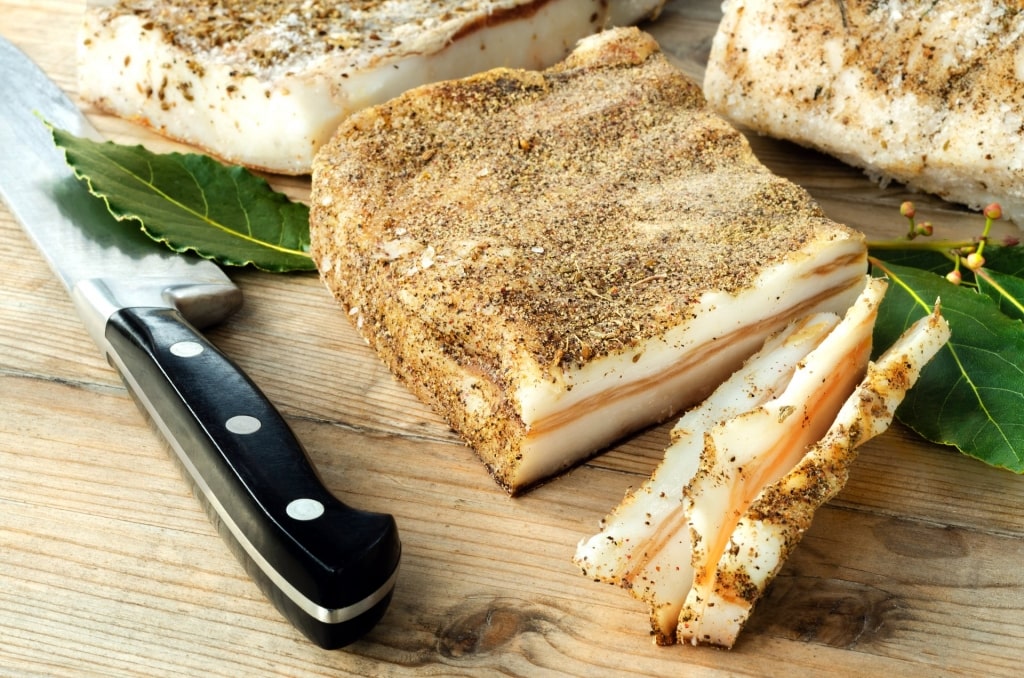
Lardo di Colonnata
Colonnata is a village tucked away in the coastal Apuan Alps, north of the beautiful walled city of Lucca. You’ll see Colonnata’s marble—the village’s most famous export—in all of the region’s historic sites and art galleries. Be sure, however, to also appreciate its other famous export: lardo di colonnata.
This IGP-protected specialty salumi is a gem of Tuscan cuisine. The traditional technique for curing these marble white cuts of pork fat has been handed down through the centuries. The fat is topped with a bed of rosemary, garlic, pepper, and salt—although some variants include cloves or oregano—before it is cured in a basin made from the area’s famous marble.
You’ll find rich, creamy lardo di colonnata melted into luxurious sauces, stuffed inside fried sgabei (a kind of doughnut), or folded onto bruschetta and brushed with the region’s fresh and vegetal extra virgin olive oil.
Cacciucco
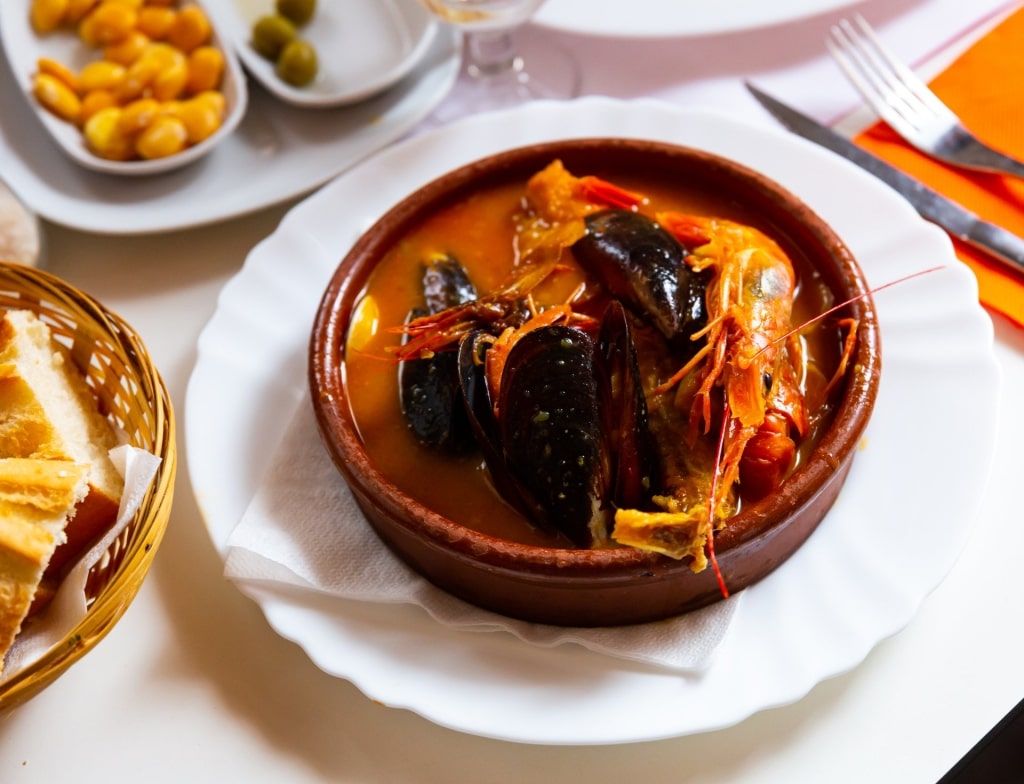
Cacciucco
Tuscan food makes many uses of the Tyrrhenian Sea’s bounty, but it’s cacciucco that is the regional seafood’s standard-bearer.
Eschewing the accepted wisdom of pairing fish with a local white wine like Vermentino, cacciucco is a rich fisherman’s stew of red wine and tomato broth that’s crammed with seafood and served over toasted Tuscan garlic bread. While the traditional recipe calls for a trawler’s haul of thirteen species as a minimum, this has since been reduced to a more modest six or eight. A typical recipe usually includes squid and octopus, adding to the dish’s textural depth.
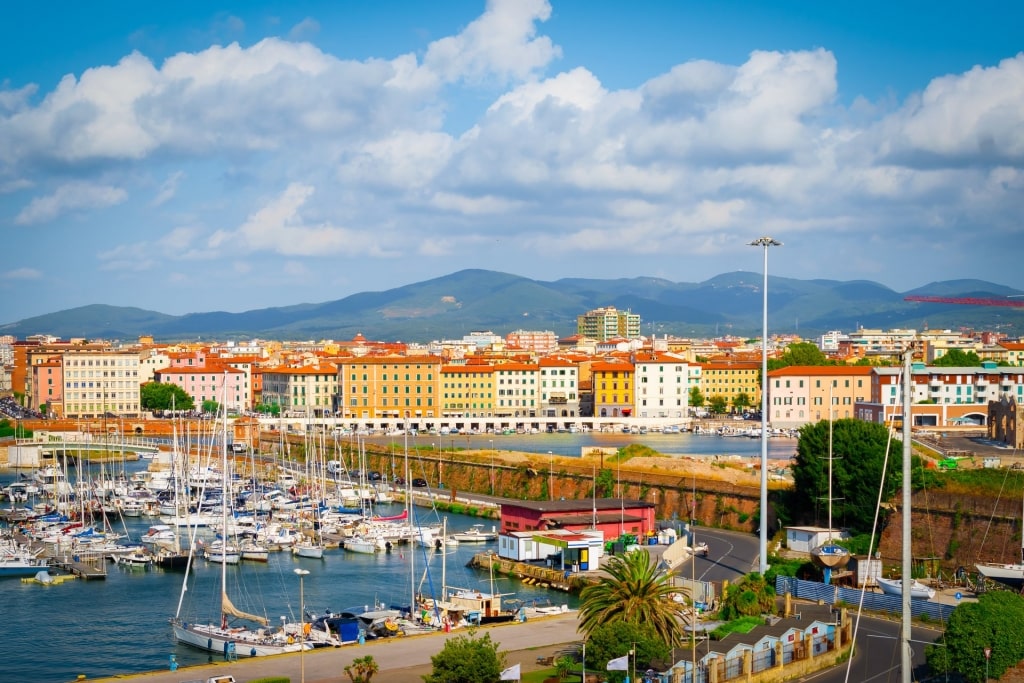
Livorno, Tuscany
Cacciucco is most famously associated with the port city of Livorno, although you’ll also find it served along the Ligurian coast to the north. While the name is derived from the Turkish word for small, various legends surround its creation. Perhaps the most widely retold is that of a newly widowed fisherman’s wife, unable to feed her children, who had fish donated from all over the village to her pot. Voila—hearty cacciucco was born.
More likely is that, similar to bouillabaisse in Marseille, the dish was developed in the early 1500s as a means by which fishermen could use up the smaller fish that was left unsold. With its role as a central commercial port for renaissance Italy, Livorno’s culinary heritage is rich and complex.
Book a guided culinary tour of its indoor produce market to gain a first-hand understanding of this heritage—including a date with one of the city’s finest examples of cacciucco.
Torta di Ceci
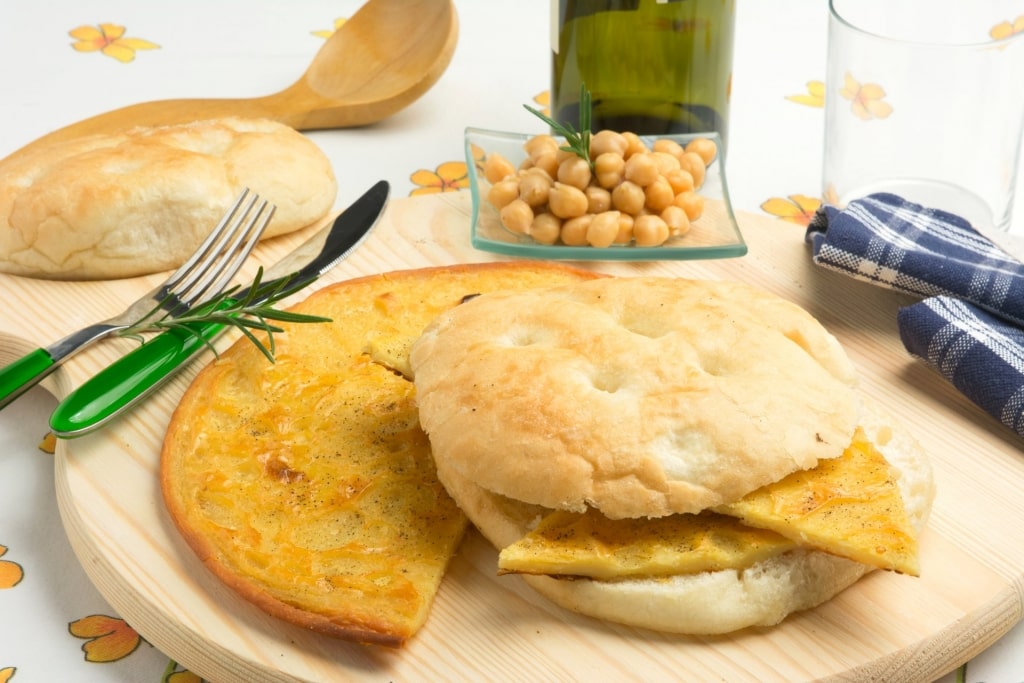
Torta di Ceci
A lighter recipe from the Livornese is torta di ceci, a pancake of chickpea flour that’s occasionally used as a base for pizza. It’s this port city’s most famous street food, traditionally cooked in disc-like copper pans until it acquires a golden crust and seasoned with rock salt and rosemary sprigs. Biting into the resulting wedges offers up the same mouthfeel as a successfully baked cookie: hard and crisp outside, chewy in the middle.
With its simplicity matched only by its deliciousness, you’ll find versions of torta di ceci as far away as neighboring France. The Livornese, however, swear blind that it was their invention. Find a tortai kiosk on the street and ask for a “cinque e cinque”—this refers to the historic sums of five lire for the torta and five lire for the focaccia that the crisp wedges are served in.
Pici all’aglione
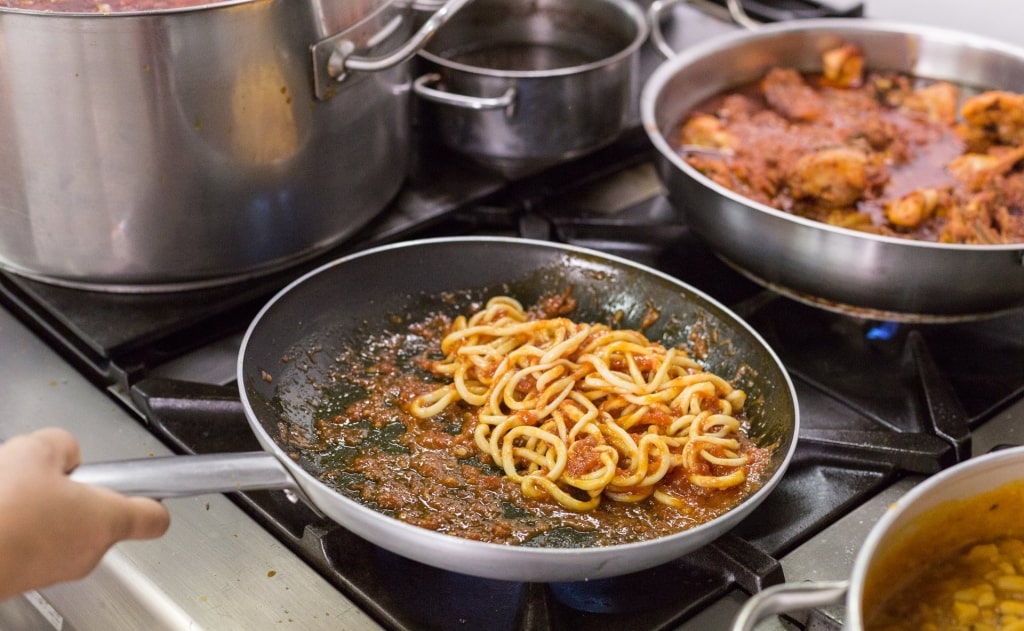
Pici all’aglione
Pici pasta heralds from the winding medieval alleyways of Siena and the city’s nearby stretch of immaculate Tuscany known as the Val D’Orcia. Resembling stouter versions of spaghetti, the name of this rustic and chewy carbohydrate is derived from the Italian for hand-rolled—appiciare. As this name suggests, pici predates pasta machines, with these satisfying noodles originally the hand-rolled product of the ancient Etruscans.
Made from flour and water, Tuscans add egg to the mix for special occasions and indulgent Sunday feasting. Try these icons of Tuscan food in atmospheric Siena, and you’ll probably have them served in breadcrumbs or all’aglione—a tomato sauce made with the indigenous aglione variety of garlic.
Potato Tortelli
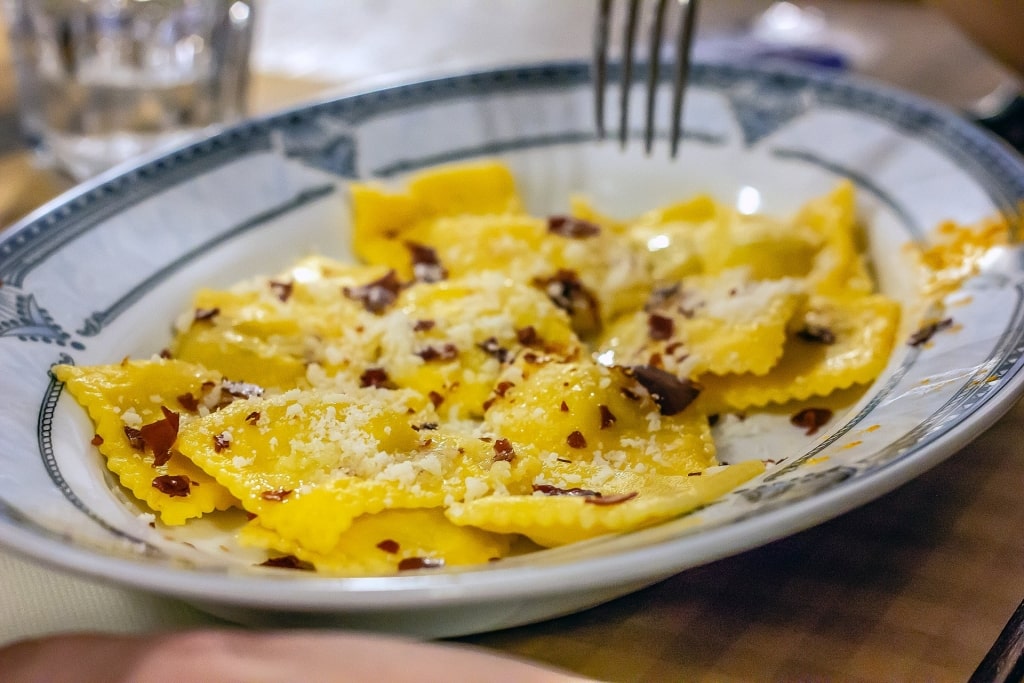
Potato Tortelli
For those with a dedication to carbohydrate-heavy dining, Tuscany’s Mugello region is your spiritual home.
From the mountains north of Florence comes the zenith of Tuscan cuisine’s comfort food: potato tortelli. These soft yellow egg pasta parcels are plumped up with fragrant mashed potato, often blended with tomato, garlic, spices, and Parmigiano Reggiano, before being served with rich ragu. There’s a rarer, more rustic version where the filling is simply chestnuts.
Cantucci
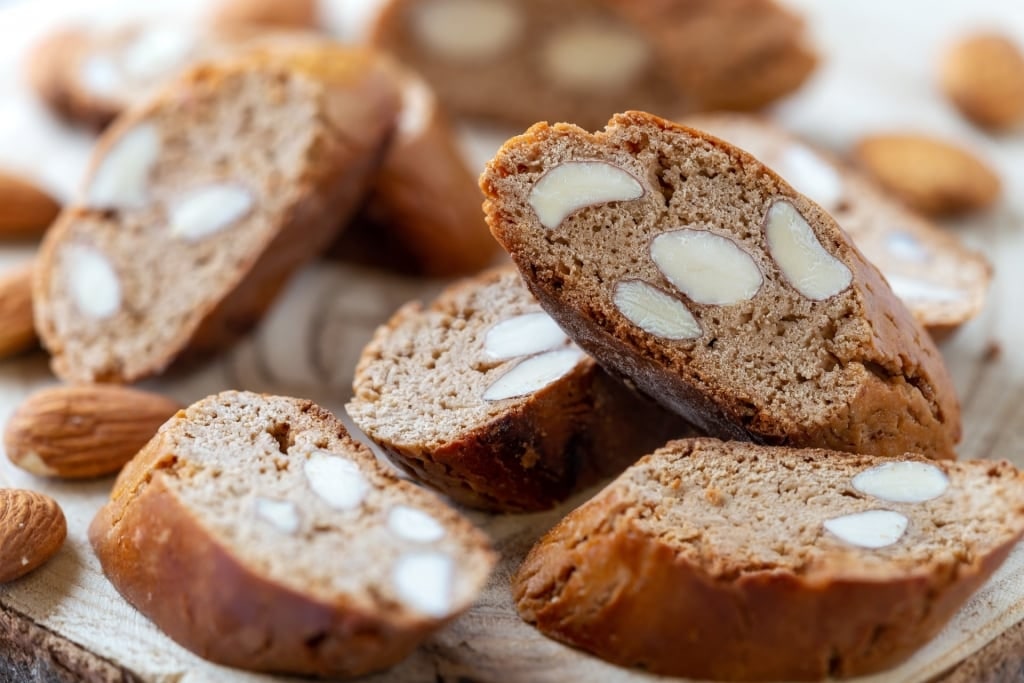
Cantucci
Arguably Tuscan food’s most famous export, cantucci are hard almond biscuits more widely known as biscotti. Outside of the region, they’re most commonly found balanced on an espresso saucer, their sweet nuttiness a foil for the coffee’s bitterness.
Cantucci’s generic name is actually a shortening of Biscotti di Prato. Prato is the almond grove-encircled city, just north of Florence, given credit for these crunchy, twice-baked miracles. The tradition of twice-baking cookies reaches into Roman times, the process ensuring an extra-long life for sea voyages and expeditionary legions.
Cantucci—and their diminutive brethren, cantuccini—always contain almonds, but otherwise, they’re ripe for tweaking with chocolate chips, pistachios, or dried fruit. While it’s a coffee add-on worldwide, in Tuscany, cantucci are often served for dipping in Vin Santo dessert wine at the end of a decadent meal.
Torta della Nonna
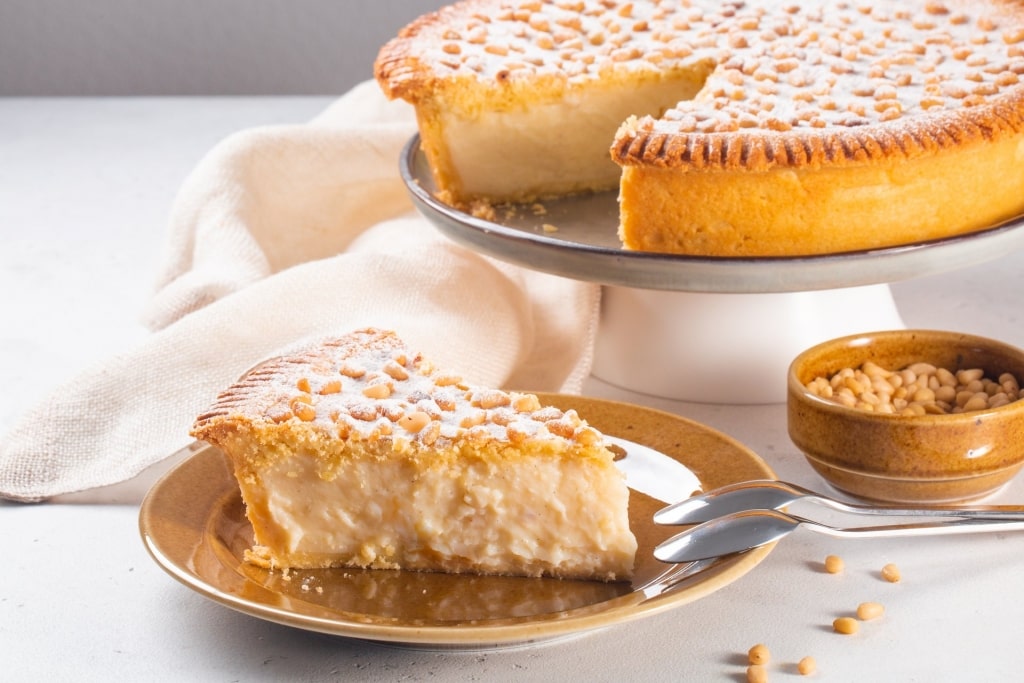
Torta della Nonna
Another treat developed in Tuscany before being embraced by the entire Italian peninsula is torta della nonna. While the name hints at the kind of rustic, homegrown culinary miracle at which the Italians excel, this cake is not attributed to anyone’s grandma. Torta della nonna was actually the brainchild of a mid-twentieth century Tuscan restaurateur whose customers had become bored with his dessert list.
Who needs romantic origin stories when something tastes this good? Torta della nonna is a sugar pastry custard tart made fragrant with lemon zest and finished with pine nuts. Simple and extraordinary—no wonder it has been so swiftly anointed as a traditional dessert for the whole of Italy.
Necci
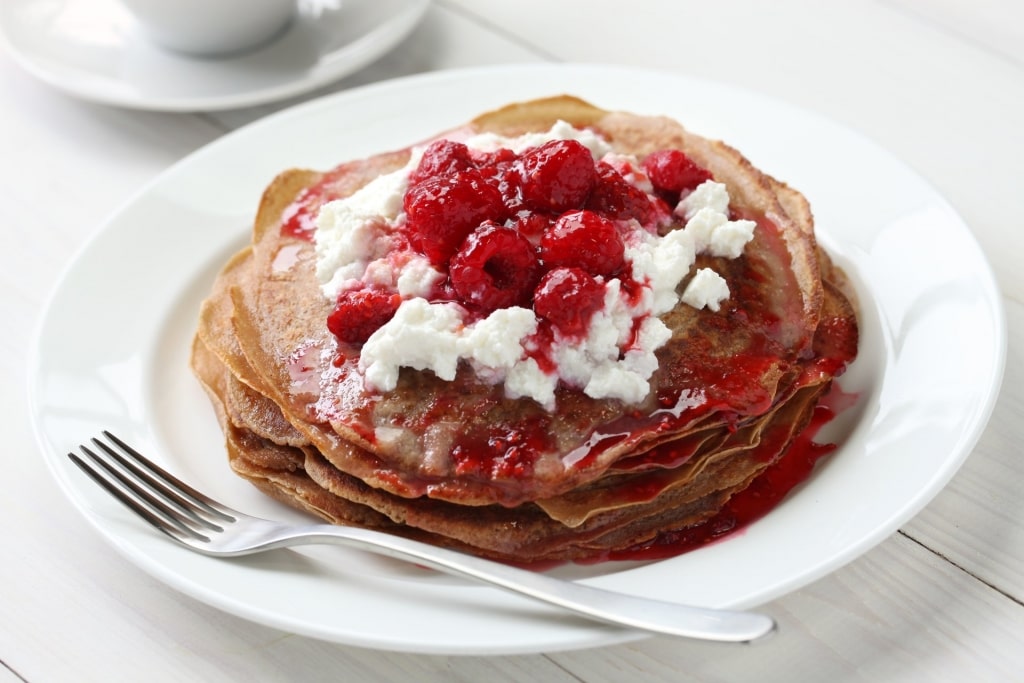
Necci
A popular street food, necci are chestnut flour pancakes wrapped around a cumulus cloud of creamy ricotta. While chestnut flour is seen as a luxury in some countries, it was employed as a cucina povera alternative by Tuscany’s poor.
Today, necci are most common during autumn, when stalls pop up at festivals celebrating the harvest festival. Made of chestnut flour, water, and olive oil, these pancakes were originally cooked on smooth stones warmed in the oven.
It’s a griddle nowadays, although the rest has remained the same, with a drizzle of sweet honey the traditional topping for the ricotta. Charcuterie also works well inside these light and tasty pancakes. If you can find any, the cinnamon and anise-spiced slices of Tuscan biroldo sausage come highly recommended—a sausage made from the leftover parts of the pig. Cucina povera perfetto!
Read: What to Eat in Bologna
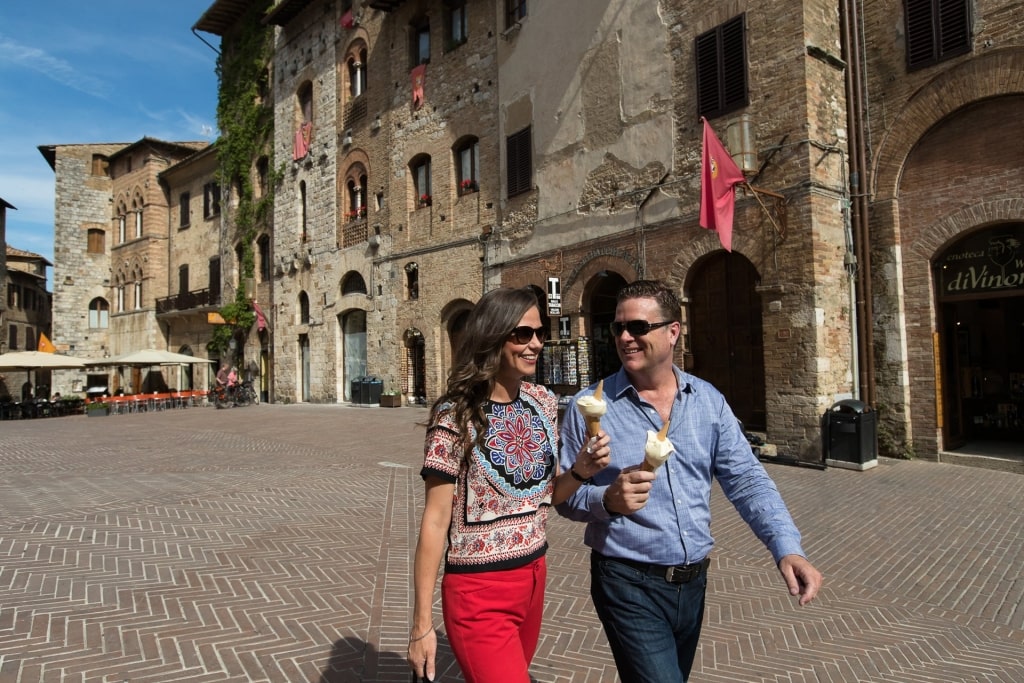
Florence, Tuscany
Explore Tuscany’s immense art, culture, and culinary heritage on a cruise to Italy. Browse our cruise itineraries online and book a cruise vacation to this stunning country today.
